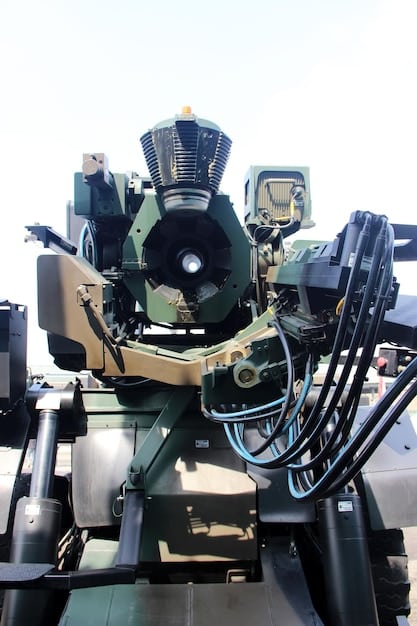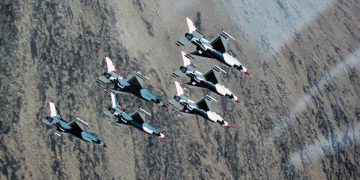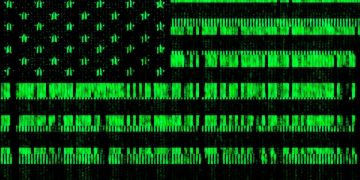Directed Energy Weapons: US vs. Russian Tech Advancements

Directed energy weapons (DEWs) represent a cutting-edge area of military technology, with both the US and Russia making significant strides in their development, focusing on lasers, microwaves, and particle beams for various defense and offense applications.
Entering the realm of futuristic warfare, directed energy weapons: a comparison of US and Russian technological advancements reveals a fascinating competition. We delve into the high-tech arsenals of these global powers, exploring the power, potential, and implications of these innovative weapons.
Understanding Directed Energy Weapons (DEWs)
Directed energy weapons (DEWs) are a revolutionary class of armament that use concentrated electromagnetic energy or atomic particles to disable, damage, or destroy targets. Unlike traditional weapons that rely on kinetic energy or explosives, DEWs offer the potential for precision strikes, scalable effects, and reduced collateral damage. The US and Russia have been at the forefront of developing DEWs since the Cold War era, investing heavily in research and development programs.
These weapons include lasers, microwaves, and particle beams. Lasers use intense beams of light to burn or blind targets. Microwaves disrupt electronic systems. Particle beams damage materials at the atomic level.
Key Types of DEWs
Directed energy weapons represent a significant shift in military technology. Here are some of the primary types:
- Laser Weapons: Systems that use highly focused beams of light to achieve effects ranging from burning and melting to blinding sensors.
- Microwave Weapons: Devices that emit high-powered microwaves to disrupt electronic equipment, causing temporary or permanent damage.
- Particle Beam Weapons: Weapons that fire accelerated particles at near-light speed to damage targets at the atomic level, potentially causing structural failure.
DEWs have the potential to transform warfare. They offer precision, speed, and scalability. However, challenges remain in terms of power, size, and atmospheric interference.

US Directed Energy Weapon Programs
The United States has made substantial investments in directed energy weapon technology. These programs aim to develop DEWs for air, land, and sea applications.
The US military has been actively developing laser and microwave weapons for defense. These efforts cover a wide range of applications, from missile defense to counter-drone systems. Let’s explore the advancements.
Key US Programs
The US is pursuing multiple DEW programs. Here are some notable examples:
- Laser Weapon System (LaWS): A ship-based laser weapon developed by the US Navy that can disable or destroy drones and small boats.
- High Energy Laser Mobile Demonstrator (HEL MD): A ground-based laser system that can intercept rockets, artillery, and mortars.
- Counter-Electronics High Power Microwave Advanced Missile Project (CHAMP): A missile-borne microwave weapon designed to disrupt or destroy electronic systems within buildings or other structures.
US DEW programs are focusing on improving the power, precision, and portability of these weapons. The goal is to deploy DEWs on a variety of platforms, enhancing defense capabilities.
The US seeks to integrate directed energy weapons into its armed forces. These weapons provide new options for defense and could change the way battles are fought.
Russian Directed Energy Weapon Programs
Russia has also been making significant advancements in directed energy weapons. Its programs are often shrouded in secrecy, but some details have emerged about its capabilities.
Russia’s approach to DEWs is characterized by a mix of known projects and classified research. Its focus is on disrupting enemy tech and defending against attack.

Notable Russian DEW Initiatives
Russia is developing a range of DEWs. Some examples include:
- Laser Systems: Used for disabling enemy satellites and aircraft, with reports suggesting deployment of laser systems for counter-space capabilities.
- Microwave Weapons: Designed to disrupt or destroy electronic equipment.
- Mobile Directed Energy Systems: Integrated on vehicles for battlefield use.
Russian DEW programs are aimed at defending against advanced weapons. They could change the dynamics of future conflicts and defend against missile attacks.
Comparing Technological Approaches
While both the US and Russia are investing heavily in directed energy weapons, their approaches and focus areas differ in some key respects.
The US focuses on laser weapons for defense, while Russia prioritizes microwave weapons for electronic warfare. Let’s examine the differences.
Key Differences in Approach
- Laser Technology: The US is investing heavily in high-energy lasers for missile defense and close-range protection. Russia has demonstrated lasers capable of damaging satellites in orbit.
- Microwave Technology: Russia has emphasized microwave weapons for disabling electronic systems, while the US has focused on tactical applications.
- Development Philosophies: The US favors transparent testing and public demonstrations. Russian programs are more secretive, with limited public knowledge of their progress.
Both nations are advancing directed energy weapons, but their approaches and development priorities reflect different strategic priorities and technological strengths.
The US and Russia continue to innovate. This could lead to breakthroughs that change the future of warfare and defense.
Challenges and Limitations
Despite the enormous potential of directed energy weapons, several challenges and limitations still need to be addressed for their widespread adoption.
DEWs must overcome power, weather, and size challenges. Discover the main obstacles and solutions.
Significant Barriers
There are several technical obstacles to overcome for the practical, every-day use of these weapons:
- Power Requirements: DEWs require significant power, presenting challenges for mobile deployment and operational endurance.
- Atmospheric Interference: Weather conditions and atmospheric turbulence can affect the propagation and effectiveness of directed energy beams, particularly lasers.
- Size and Weight: Current DEW systems are often large and heavy, limiting their deployment on smaller platforms or in austere environments.
Overcoming these barriers is essential for DEWs to become mainstream. The future of these systems depends on innovations that reduce these challenges and improve performance.
New tech is improving DEWs and making them more practical. This is promising for the future of defense.
Future Trends and Implications
The future of directed energy weapons is likely to be shaped by technological advancements and evolving geopolitical dynamics.
As technology improves and threats evolve, expect to see more DEWs on the battlefield. Here are some key trends.
Expected Developments
The world of DEWs is always changing. Look for these future events:
- Miniaturization: Advancements in materials science and electronics are expected to lead to smaller, more portable DEW systems.
- Increased Power: Ongoing R&D efforts are focused on increasing the power output of DEWs.
- Integration: DEWs will be integrated into existing defense systems for better defense.
The rise of DEWs could change military strategy. Understanding these changes is important for security and defense planning.
Both the US and Russia are looking ahead. Their progress will shape the future of military technology and global security.
| Key Point | Brief Description |
|---|---|
| ⚡ US Laser Programs | Focus on high-energy lasers for missile defense and close-range protection. |
| 📡 Russian Microwave Weapons | Emphasis on microwave weapons designed to disrupt electronic systems. |
| 🛡️ DEW Limitations | Challenges include high power requirements and atmospheric interference. |
| 🚀 Future Integration | DEWs will integrate into defense systems for broader applications in defense. |
Frequently Asked Questions (FAQ)
▼
Directed energy weapons are weapon systems that use focused electromagnetic energy or atomic/subatomic particles to damage or destroy targets. They include high-energy lasers, high-power microwaves, and particle beams.
▼
The US Navy’s Laser Weapon System (LaWS), the High Energy Laser Mobile Demonstrator (HEL MD), and the Counter-Electronics High Power Microwave Advanced Missile Project (CHAMP) are US programs.
▼
Russian DEWs include laser systems for disabling satellites and aircraft and microwave weapons designed to disrupt or destroy electronic equipment. Some are integrated into mobile systems deployable on the battlefield.
▼
DEWs face challenges, including high power requirements, atmospheric interference impacting beam accuracy, and issues regarding size and weight that limit mobility on platforms.
▼
DEWs are expected to become smaller and more portable due to advances in technology. It is anticipated that ongoing R&D will increase power, better integrating DEWs into present defense systems.
Conclusion
As both the US and Russia continue to push the boundaries of directed energy weapon technology, these advancements promise to reshape the future landscape of military capabilities and strategies, requiring a careful consideration of their potential impact on global security.





